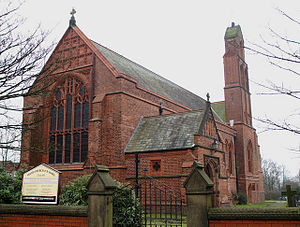- St James' Church, Daisy Hill
-
St James' Church, Daisy Hill 
St James' Church, Daisy Hill, from the southwestLocation in Greater Manchester Coordinates: 53°32′05″N 2°31′05″W / 53.5346°N 2.5180°W OS grid reference SD 658 044 Location Daisy Hill, Westhoughton, Bolton, Greater Manchester Country England Denomination Anglican Website St James, Daisy Hill History Founded 24 February 1879 Dedication Saint James the Great Consecrated 22 April 1881 Architecture Status Parish church Functional status Active Heritage designation Grade II* Designated 19 August 1986 Architect(s) Paley and Austin Architectural type Church Style Gothic Revival Groundbreaking 24 February 1879 Completed 1881 Construction cost £6,500 Specifications Capacity 410 Length 124 feet (37.8 m) Nave width 48 feet (14.6 m) Materials Brick with terracotta dressings,
slate roofsAdministration Parish St James, Daisy Hill Deanery Deane Archdeaconry Bolton Diocese Manchester Province York Clergy Vicar(s) Fr Jeremy Brading St James' Church, Daisy Hill, is located in the Daisy Hill district of Westhoughton, Bolton, Greater Manchester, England. It is an active Anglican parish church in the deanery of Deane, the archdeaconry of Bolton, and the diocese of Manchester.[1] The church has been designated by English Heritage as a Grade II* listed building.[2]
Contents
History
The church was built between 1879 and 1881, and was designed by the Lancaster architects Paley and Austin. Its cost of £6,500 (£490,000 as of 2011)[3] was met by two sisters, Mrs Makant and Miss Haddock. The authors of the Buildings of England series state that the church is "a masterly performance for relatively little cash".[4] Building work began on 24 February 1879, when the first sod was turned by Miss Haddock, and the foundation stone was laid by Mrs Makant.[5] The church was consecrated on 22 April 1881 by the Bishop of Manchester.[6] Daisy Hill became a separate parish in 1884.[7]
Architecture
Exterior
St James' is constructed in brick with terracotta dressings, with a small number of stone dressings.[4] The roofs are slated. Its plan consists of a three-bay nave, a north porch, a chancel, a north transept and vestry, and a bell turret on the south side. All the windows contain Perpendicular-style tracery. The windows along the sides of the church have three lights. The porch is gabled, and has a pointed arch with carvings in the spandrels. At the west end of the church is a five-light window. The transept has a hipped roof, and a projecting entrance also under a hipped roof. There are two-light windows in the organ loft and in the vestry. The east window has six lights, and there are four-light windows in the north and south sides of the chancel. The bell turret is in three stages. The lowest stage contains an entrance with a pointed arch, and round-headed windows. In the middle stage is a two-light window, and small windows illuminating the stair contained within the turret. In the top stage are two bell openings, with a third bell opening above them. At the top of the bell turret is a gable surmounted by a weathercock.[2]
Interior
Inside the church the brick is bare. The nave has a tie-beam roof, and the chancel has a boarded wagon roof. In the chancel are two sedilia and an aumbry, both in terracotta. The reredos dates from 1924, and is by Shrigley and Hunt. Also in the church is a Pre-Raphaelite painting by Alfred Charles Weatherstone. In the east window is stained glass made by Morris & Co., depicting the Epiphany. In the transept is a stained glass dating from 1943 designed by Edith Norris. The only monument in the church is to the memory of its first vicar, who died in 1911.[4] The three-manual organ was built in 1883 by W. E. Richardson at a cost of about £3,000 (£220,000 as of 2011).[3][8]
See also
- List of ecclesiastical works by Paley and Austin
References
- ^ St James, Daisy Hill, Church of England, http://www.achurchnearyou.com/daisy-hill-st-james/, retrieved 3 September 2011
- ^ a b Church of St James, Westhoughton (1067273). National Heritage List for England. English Heritage. Retrieved 3 September 2011.
- ^ a b UK CPI inflation numbers based on data available from Lawrence H. Officer (2010) "What Were the UK Earnings and Prices Then?" MeasuringWorth.
- ^ a b c Hartwell, Clare; Hyde, Matthew; Pevsner, Nikolaus (2004), Lancashire: Manchester and the South-East, The Buildings of England, New Haven and London: Yale University Press, pp. 676–677, ISBN 0-300-10583-5
- ^ History: First steps towards a parish, St James the Great, Daisy Hill, http://www.stjamesdaisyhill.co.uk/28.html, retrieved 3 September 2011
- ^ History: The Consecration, St James the Great, Daisy Hill, http://www.stjamesdaisyhill.co.uk/29.html, retrieved 3 September 2011
- ^ History: The Parish is launched, St James the Great, Daisy Hill, http://www.stjamesdaisyhill.co.uk/30.html, retrieved 3 September 2011
- ^ Lancashire (Manchester, Greater), Westhoughton, St. James, Daisy Hill (N10975), British Institute of Organ Studies, http://www.npor.org.uk/cgi-bin/Rsearch.cgi?Fn=Rsearch&rec_index=N10975, retrieved 3 September 2011
Categories:- Grade II* listed churches
- Grade II* listed buildings in Greater Manchester
- Religious buildings completed in 1881
- 19th-century Anglican church buildings
- Anglican congregations established in the 19th century
- Gothic Revival architecture in Greater Manchester
- Anglican Diocese of Manchester
- Paley and Austin buildings
Wikimedia Foundation. 2010.

